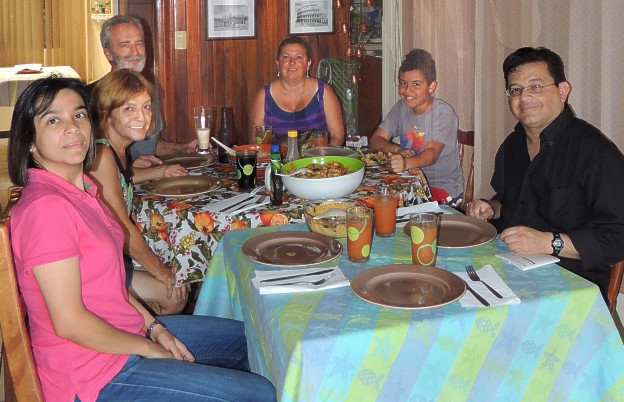
Kansas Snapshots by Gloria Freeland - Nov. 16, 2012
The tale of the spotted rooster
In last week's column about my Costa Rican trip, I mentioned a dish called "gallo pinto." It's a staple of the local diet and is principally rice and black beans. The name translates to "spotted rooster." I have been told that during colonial times, the beans mixed with rice were the red-bean variety. In Latin America, roosters are usually red and white, and so that was how the dish got its name.
After my column ran, I received a note from one of the people I met there, who explained that gallo pinto is much more than rice and beans. His comment prompted me to think about other aspects of the Costa Rican culture that differ from ours.
For one, the hospitality of the Ticos - as Costa Ricans refer to themselves - is almost legendary. Beginning with my arrival at my friend Eve and her husband Charles' home in Atenas, I felt surrounded by warmth and affection. All greetings between their countrymen involved a peck on the cheek.
Kansas had many horses long before it was settled and so horse-drawn wagons were common in the sunflower state. But oxen and oxcarts were rare. In Costa Rica, oxcarts were widely used to transport coffee beans. So today, a trip to Sarchi where brightly-painted oxcarts, wooden furniture and wooden crafts are made is a "must see" for visitors. While Eve and I were there, we posed by the "world's largest oxcart" and shopped for small wooden boxes, bracelets made of wood, coffee candy chews and paper made of recycled mango, coffee and banana leaves. The courtyard behind one shop had papaya, banana, coffee and other exotic plants - things we certainly don't see much of in Kansas!
In preparation for my meetings at the university, I moved into a lovely hotel right across the street. That Costa Rican friendliness again shone through when the owner, Randolph, showed me my spacious suite - complete with living room, kitchenette, large bedroom and blue- and white-tiled bath. He said I was welcome to use the lobby, breakfast room or courtyard areas if I wanted. Then, instead of just showing me a map, he drove me around the neighborhood to point out where restaurants and grocery stores were located. I had some trouble recalling the last time the proprietor of a place I was staying at gave me such a personal tour.
While my meetings were productive, they were more than that. The people at each of the places I visited were gracious, warm, helpful and full of life.
Back with Eve and Charles for a last day of visiting before I had to leave, we did another "tour" of downtown Atenas, where I was again amazed by the bougainvilleas, orchids, birds of paradise, gardenias, palms and other tropical flowers and trees. We went by the outdoor market stalls - some with vegetables and fruit, some with meat and fish, some with household items.
As we stepped from the front door of a church we had just visited, Eve stopped me and told me to take out my camera. I did so and, following her lead, slowly moved around the corner. A large iguana was perched at the top of the steps - again, not exactly an everyday sight for us Kansans!
Our time together ended with more fresh papaya, mango, bananas, pineapple and Eve's version of gallo pinto - complete with meat, onions, tomatoes and other vegetables.
Oh, and that note I mentioned earlier that caused me to reflect on all these differences? It was from Eve's brother, Javier.
"Gallo Pinto is not merely 'rice and beans.' It is a complex dish on its own, made with onions, green pepper, wild coriander and, very importantly, our own Salsa Lizano (a Latin version of Worcestershire sauce), with a cultural meaning born out of the clash between the Spanish conquerors and the natives. There are versions of it all over the Caribbean area with some changes in the ingredients. In Nicaragua it is called 'Gallopinto' while in Cuba it is called Moros y Cristianos ('Moros' means 'Moors,' the medieval North African invaders that conquered and controlled Spain for about 800 years) congrí or congrís. The Puerto Rican version is called 'arroz con habichuela' and the recipe is quite different from our national dish.
In Costa Rica, if you say 'Rice and beans' (in English) it means the Caribbean dish made with coconut milk, coconut oil and a hot sauce made with tomato and Panamanian Hot Pepper (which is so strong the actual pepper is just placed in the sauce for a while. If the pepper bursts the sauce cannot be eaten), and it usually includes spicy chicken. Gallo Pinto and Rice and Beans are totally different dishes with their own historical roots. It is sad when foreigners dismiss them as merely 'rice and beans.' They are so much more."
So even after my trip was over, I gained some additional appreciation for Costa Rica - the country I once called home and which I recently became re-acquainted with. Its name means "rich coast" in Spanish and it IS filled with many riches - its people, its climate, its gorgeous landscapes - and, of course, its gallo pinto.

Top, "World's largest oxcart" in Sarchi; bottom, our iguana on the church steps in Atenas.

From left: Ana Maria, Javier's girl friend; Eve; Charles; Marianela, Eve's niece; Fabrizio, Marianela's son; and Javier.
Comments? [email protected].
Earlier columns from 2012 may be found at: 2012 Index.
Links to previous years are on the home page: Home